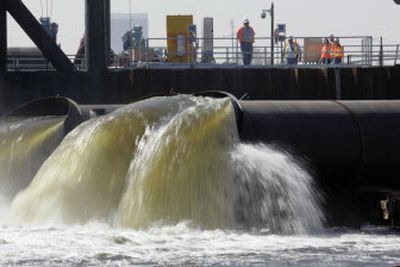Post-Katrina pumps defective, documents show

NEW ORLEANS – The Army Corps of Engineers, rushing to meet President Bush’s promise to protect New Orleans by the start of the 2006 hurricane season, installed defective flood-control pumps last year despite warnings from its own expert that the equipment would fail during a storm, according to documents obtained by the Associated Press.
The 2006 hurricane season turned out to be mild, and the new pumps were never pressed into action. But the corps and the politically connected manufacturer of the equipment are still struggling to get the 34 heavy-duty pumps working properly.
The pumps are now being pulled out and overhauled because of excessive vibration, corps officials said. Other problems have included overheated engines, broken hoses and blown gaskets, according to the documents.
Col. Jeffrey Bedey, who is overseeing levee reconstruction, insisted the pumps would have worked last year and the city was never in danger. Bedey said the pumps should be ready for the coming hurricane season, which begins June 1.
The corps said it decided to press ahead with installation and then fix the machinery while it was in place, on the theory that some pumping capacity was better than none. And it defended the manufacturer, which was under time pressure.
“Let me give you the scenario: You have four months to build something that nobody has ever built before, and if you don’t, the city floods and the corps, which already has a black eye, could basically be dissolved. How many people would put up with a second flooding?” said Randy Persica, the corps’ resident engineer for New Orleans’ three major drainage canals.
The 34 pumps – installed in the drainage canals that take water from this bowl-shaped, below-sea-level city and deposit it in Lake Pontchartrain – represented a new ring of protection that was added to New Orleans’ flood defenses after Katrina. The city also relies on miles of levees and hundreds of other pumps in various locations.
The drainage-canal pumps were custom-designed and built under a $26.6 million contract awarded after competitive bidding to Moving Water Industries Corp. of Deerfield Beach, Fla.
Because of the trouble with the New Orleans pumps, the corps has withheld 20 percent of the MWI contract, including an incentive of up to $4 million that the company could have collected if it delivered the equipment in time for the 2006 hurricane season.
Misgivings about the pumps were chronicled in a May 2006 memo provided to the Associated Press by Matt McBride, a mechanical engineer and flooded-out Katrina victim who, like many in New Orleans, has been closely watching the rebuilding of the city’s flood defenses.
The memo was written by Maria Garzino, a corps mechanical engineer overseeing quality assurance at an MWI test site in Florida. The corps confirmed the authenticity of the 72-page memo, which details many of the mechanical problems and criticizes the testing procedures used.
About a dozen of the 34 pumps on order were already in place in New Orleans when Garzino wrote her report, according to Bedey.
In her memo, Garzino told corps officials that the equipment being installed was defective. She warned that the pumps would break down “should they be tasked to run, under normal use, as would be required in the event of a hurricane.”
The pumps, 60 inches in diameter and capable of moving 200 cubic feet of water per second, are run by pressurized hydraulic oil. The supercharged oil cranks up a hydraulic motor, which in turn spins water-moving propellers.
The pumps failed less-strenuous testing than the original contract called for, according to the memo. Originally, each of the 34 pumps was to be “load tested” – made to pump water – but that requirement for all the pumps was dropped, the memo said.
Of eight pumps that were load tested, one was turned on for a few minutes and another was run at one-third of operating pressure, the memo said. Three of the other load-tested pumps “experienced catastrophic failure,” Garzino wrote.
MWI vice president Dana Eller said Garzino’s conclusions about the pumps were premature. “She was there when we turned on the switch,” he said. “If you put your garden hose on and it’s leaking a bit, you’d tighten the garden hose. So that’s what we did.”
Bedey said some of what Garzino wrote was alarming and “caused me to ask a series of questions” about the reliability of the pumps. But he said they would have pumped water if they had been needed last hurricane season.
Just in case, the corps brought in numerous portable pumps last year and plans to do the same thing this year, officials said.
In the meantime, the corps has paid MWI $4.5 million for six additional pumps and will use them to troubleshoot the defective ones, Bedey said. Four of those pumps were run on Saturday for more than an hour, and the corps said there were no problems with the test. They were turned on again Tuesday in a demonstration for reporters.
The corps said MWI has paid for all other expenses incurred in fixing the pumps – shipping them back and forth from a facility in Gray, La., and installing and reinstalling them.